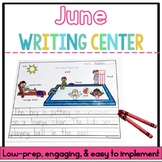27 results
1st grade Hispanic Heritage Month environment scaffolded notes

Reduce, Reuse and Recycle Natural Resources - Earth Day Lesson
Is it hard for your students to remember the difference between recycling, reducing, and reusing? These activities will give students lots of examples and opportunities to practice distinguishing between the words. Great for Earth Day or a science unit on taking care of the environment!What's Included:Vocabulary posters provide the definition of each term (reduce, reuse, recycle) two examples and pictures for each word. There are also two options of posters that include all three words on the sa
Subjects:
Grades:
1st - 2nd

Life Science Interactive Notebook Foldables (K-2)
23 INB life science activities perfect for K-2 students! Introduce life science concepts in a clear and easy way with fun foldables and activities!
Features:
-Easy cutouts that require simple assembling or folding
-Large, easy to read font
-Key science terms are in a traceable form for students to practice writing skills
Contents:
Living vs. Nonliving Sort...3-4
Living vs. Nonliving Venn Diagram...5
Characteristics of Living Things...6
Animal Needs...7
Plant Needs...8
External Animal Part
Subjects:
Grades:
K - 2nd
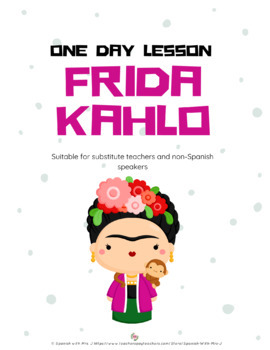
One Day Lesson or Sub Plan - Frida Kahlo
A quick, one-day lesson introducing students to the Spanish artist, Frida Kahlo. This lesson can be used with a substitute who does not speak Spanish and include no prep activities for students, a detailed lesson plan and info page about the artist.After reading a book about the artist and looking over an info sheet, students create Frida paper dolls and/or complete a mini booklet about the artist that includes target language vocabulary and a self-portrait activity. This fun lesson will not onl
Subjects:
Grades:
K - 12th
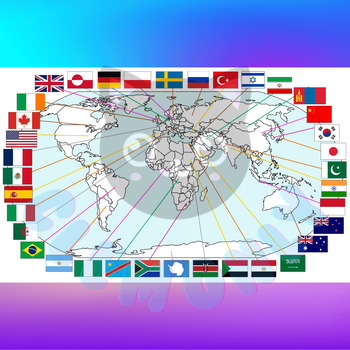
Flag Stand and World Map Control of Error Montessori
A printable product that will give your children a control of error when learning the country flags on the Flag Stand in your Montessori classroom. Print it A4 or A3 for greater clarity. The lines are clear and do not cross one another to ensure that there is no confusion when using this control of error.
Subjects:
Grades:
PreK - 5th
NGSS:
4-ESS2-2

Día de los Muertos K-8 Lesson Plans
This product is perfect for your weekly (specials) K-8 Spanish classes. I have used this as a teacher and have also passed it on to English-speaking subs with no issues. It is great as a stand-alone lesson or a sub plan. Clipart is courtesy of Kari Bolt!This cultural lesson plan includes differentiated instructions for grades K-8 through grade bands. There are also extensions included and answer keys included!Grades K-2 listen to a song, read a cultural story (Google Slides), and then have a 1-p
Grades:
K - 12th
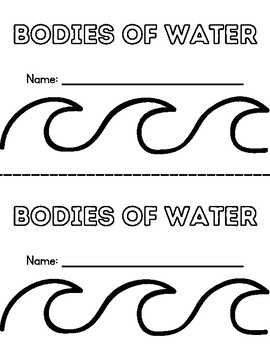
Bodies of Water Flipbook
Bodies of water flipbook. Includes traceable definitions for rivers, lakes, ponds, and oceans.
Subjects:
Grades:
PreK - 2nd

Biomes: A Research Report
This is a blank report format for students in grades first, second, third and fourth. They can use pages to report on one kind of biome, or they can report on 2 or more biomes in the same report. There are boxes and lines for pictures and writing about the animals, vegetation and seasonal changes of each type of biome. If they write about more than one biome, there is a page for comparing and contrasting.Some pages will have to be copied multiple times if they report on more than one.
Subjects:
Grades:
1st - 4th
Types:
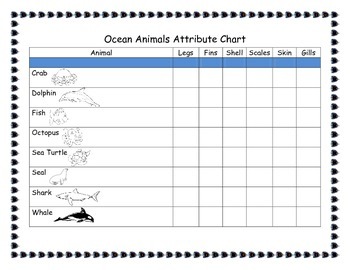
Ocean Animals Attribute Chart
Appropriate for grades K-3, this attribute chart allows students to compare and contrast animals of the ocean according to their features, or attributes. It reinforces new vocabulary and concepts learned from nonfiction texts regarding ocean animals. This can be done whole group, in small groups, or individually, depending on the grade and ability levels of the students. Fits in perfectly with an ocean unit!
Subjects:
Grades:
K - 3rd
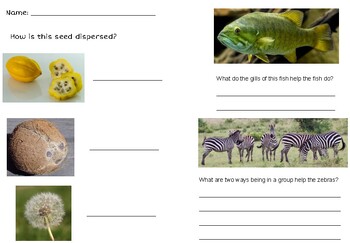
Animal Structures and Seed Dispersal Quick Check
This resources allows students to show what they know about Animal Structures and their purpose as well as how seeds are dispersed.
Subjects:
Grades:
1st - 3rd
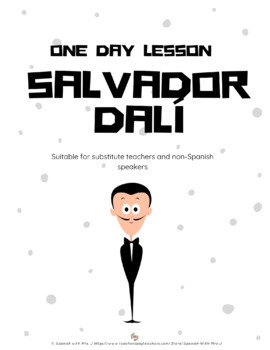
One Day Lesson or Sub Plan - Salvador Dalí
A quick, one-day lesson introducing students to the Spanish artist, Salvador Dalí. This lesson can be used with a substitute who does not speak Spanish and includes no-prep activities for students, a detailed lesson plan and info page about the artist.After reading a book about the artist and looking over an info sheet, students create a Dalí inspired piece of art. This fun lesson will not only teach your students about a famous artist but will also engage them in a fun activity that they will b
Subjects:
Grades:
K - 12th
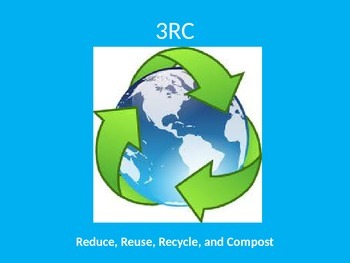
Reduce, Reuse, Recycle, and Compost PowerPoint with Fill-in Notes Sheet
This Powerpoint presentation gives an kid-friendly overview of reducing, reusing, recycling, and composting waste.
Subjects:
Grades:
1st - 6th

Science Writing: Goldfish Observations
This document contains a graphic organizer for writing observations about goldfish. Students will write three paragraphs describing their observations.
There are two pages: a blank graphic organizer with guiding questions and an organizer with guiding questions and sentence stems for ELL support.
I used it with my ELLs, and all my students were able to write three paragraphs about their goldfish.
Please download a preview file to see a partial view of the graphic organizer with sentence stems.
Subjects:
Grades:
K - 6th
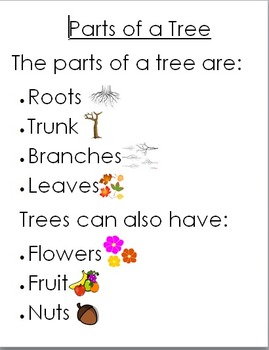
Tree Unit Notes
Notes to use with a kindergarten "trees" unit. Use alongside a science journal or worksheets.
Subjects:
Grades:
PreK - 1st
Types:
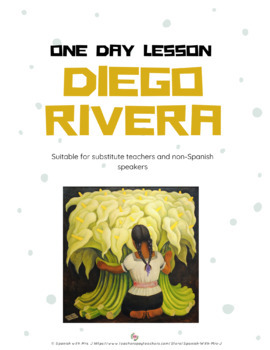
One Day Lesson or Sub Plan - Diego Rivera
A quick, one-day lesson introducing students to the Spanish artist, Diego Rivera. This lesson can be used with a substitute who does not speak Spanish and includes no-prep activities for students, a detailed lesson plan and info page about the artist.After reading a book about the artist and looking over an info sheet, students create a Diego Rivera inspired mural and/or complete a mini booklet about the artist that includes target language vocabulary. This fun lesson will not only teach your st
Subjects:
Grades:
K - 12th

Biomes and Habitats and Food Web - Graphic Organizer
Graphic organizers for the biomes, which include Temperate Forest, Tropical Rainforest, Marine, Fresh Water, Tundra, Desert, Sahara and Grasslands. A food web is included as well!
Subjects:
Grades:
PreK - 3rd
NGSS:
2-LS4-1
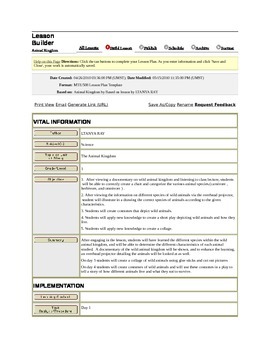
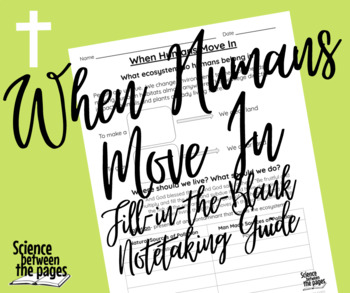
When Humans Move In Fill-in-the-Blank Notetaking Guide
Fill-in-the-Blank notetaking guide that introduces the impact humans have on an environment; part of a series on plants, animals, and the ecosystems they live and grow in; answer key included.
Subjects:
Grades:
1st - 4th

What Floats Your Boat?
In this lesson, students will be introduced to the parts of a ship and their correct names. Students will begin to understand the scientific principle of buoyancy and how the different parts of the ship are necessary to make the ship float. In the end, students will use the information obtained to create a ship out of aluminum foil that is capable of floating and carrying a “cargo.”
Subjects:
Grades:
K - 5th
NGSS:
K-2-ETS1-2
, K-2-ETS1-3
, K-PS2-2
, K-PS2-1
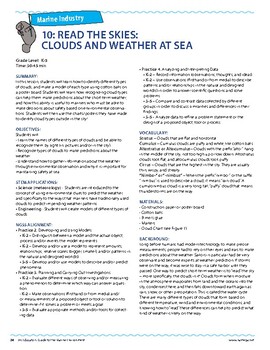
Read The Skies: Clouds and Weather at Sea
In this lesson, students will learn how to identify different types of clouds, and make a model of each type using cotton balls on a poster board. Students will learn how recognizing cloud types can help them make predictions about the short-term weather, and how this ability is useful to mariners who must be able to make decisions about safety based on environmental observations. Students will then use the charts/posters they have made to identify cloud types outside in the sky!
Subjects:
Grades:
K - 5th
NGSS:
K-ESS2-1
, K-ESS3-2
, 3-5-ETS1-2
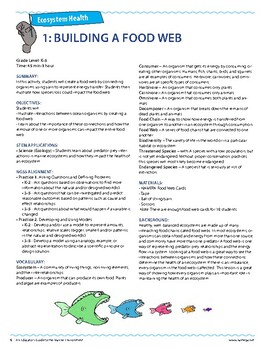
Building a Food Web
In this activity, students will create a food web by connecting organisms using yarn to represent energy transfer. Students then illustrate how species loss could impact the food web.
Subjects:
Grades:
K - 5th
NGSS:
K-2-ETS1-2
, K-2-ETS1-1
, K-ESS3-1
, 3-5-ETS1-1
, K-LS1-1
...
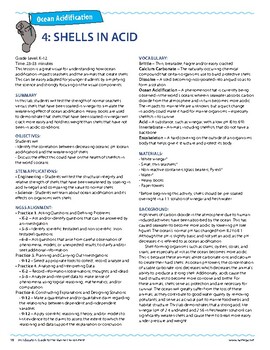
Shells in Acid
This lesson is a great visual for understanding how ocean acidification impacts seashells and the animals that create shells. This can be easily adapted for younger students by simplifying the science and strongly focusing on the visual components.
Subjects:
Grades:
K - 12th
NGSS:
1-LS1-1
, K-2-ETS1-1
, HS-ETS1-3
, 5-ESS3-1
, 2-LS4-1
...
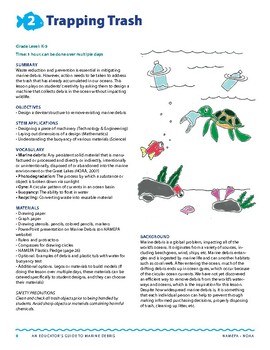
Trapping Trash
Waste reduction and prevention is essential in mitigating marine debris. However, action needs to be taken to address the trash that has already accumulated in our oceans. This lesson plays on students’ creativity by asking them to design a machine that collects debris in the ocean without impacting wildlife.
Subjects:
Grades:
K - 5th
NGSS:
K-2-ETS1-2
, K-2-ETS1-3
, 5-ESS3-1
, 2-LS4-1
, K-LS1-1
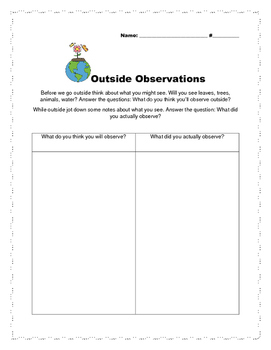
Nature Walk Observations Chart
Use this chart for students to document what they see outside!
Subjects:
Grades:
1st - 5th
Types:
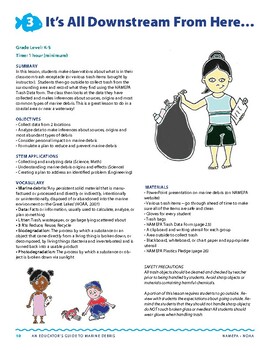
It's All Downstream From Here
In this lesson, students make observations about what is in their classroom trash receptacle (or various trash items brought by instructor). Students then go outside to collect trash from the surrounding area and record what they find using the NAMEPA Trash Data form. The class then looks at the data they have collected and makes inferences about sources, origins and most common types of marine debris. This is a great lesson to do in a coastal area or near a waterway!
Subjects:
Grades:
K - 5th
NGSS:
K-2-ETS1-3
, K-2-ETS1-1
, 3-5-ETS1-2
Showing 1-24 of 27 results







